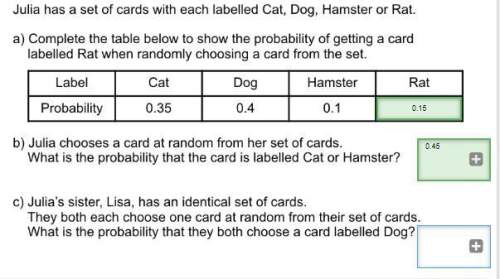
Mathematics, 26.03.2020 15:36 Christalex9874
Polygon Q(16, 4), R(8, 16), S(4, 4) was mapped to polygon T(–2, 5), U(–4, 8), V(–5, 5). First by the dilation: (x, y) → (0.25x, 0.25y). And then by which translation?
A M: (x, y) → (x – 18, y + 1)
B M: (x, y) → (x + 1, y – 18)
C M: (x, y) → (x + 4, y – 6)
D M: (x, y) → (x – 6, y + 4)

Answers: 3
Another question on Mathematics

Mathematics, 21.06.2019 13:20
Suppose that x and y are both differentiable functions of t and are related by the given equation. use implicit differentiation with respect to t to determine startfraction dy over dt endfraction in terms of x, y, and startfraction dx over dt endfraction .
Answers: 3


Mathematics, 22.06.2019 02:00
Were only 64 seats. the remaining 6 students had to travel in a separate van. the equation 2b + 6 = 70 represents the given scenario. what does b represent? the number of buses the number of vans the number of students who rode on each bus the total number of students going to the football game
Answers: 1

Mathematics, 22.06.2019 04:30
The survey of study habits and attitudes (ssha) is a psychological test that measures the motivation, attitude toward school, and study habits of students, scores range from 0 to 200. the mean score for u.s. college students is about 115, and the standard deviation is about 30. a teacher who suspects that older students have better attitudes toward school gives the ssha to 55 students who are at least 30 years of age. the mean score is 113.2. assume the population standard deviation is 30 for older students what is the margin of error for a 95% confidence interval for the population mean score for a. older students? b. compute the 95% confidence interval for the population mean score for older students. c. compute the 99% confidence interval for the population mean score for older students. d. compute the 88% confidence interval for the population mean score for older students.
Answers: 3
You know the right answer?
Polygon Q(16, 4), R(8, 16), S(4, 4) was mapped to polygon T(–2, 5), U(–4, 8), V(–5, 5). First by the...
Questions


Social Studies, 23.04.2020 17:56



History, 23.04.2020 17:56

Mathematics, 23.04.2020 17:56






Mathematics, 23.04.2020 17:56

Chemistry, 23.04.2020 17:56


Biology, 23.04.2020 17:56


Mathematics, 23.04.2020 17:56


Mathematics, 23.04.2020 17:57







